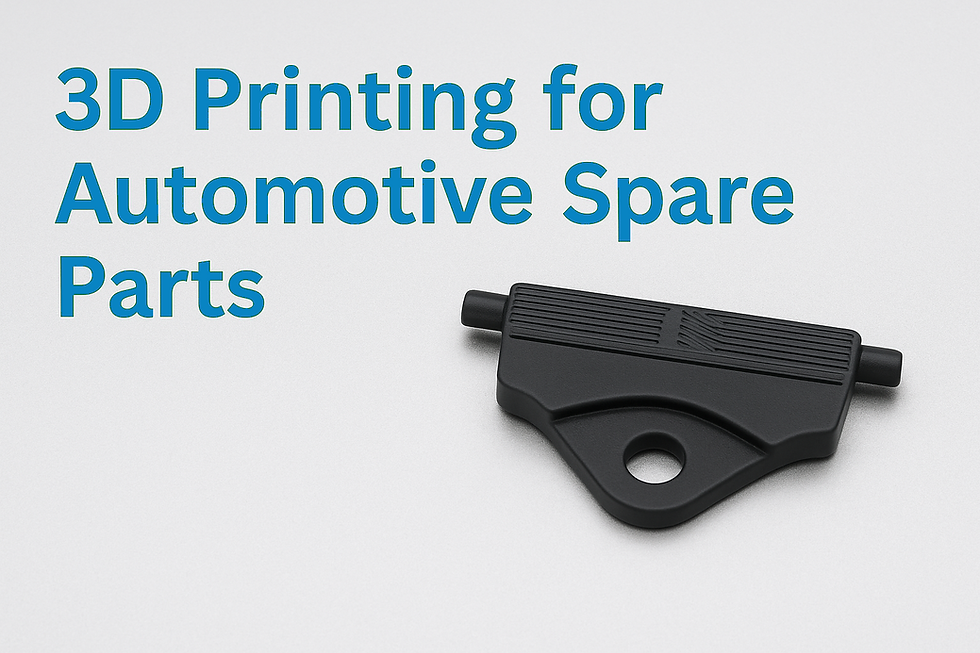3D Printing Applications in Automotive Spare Parts
- Dheeraj Varma Kalidindi
- Oct 28
- 3 min read
If you have ever had to wait weeks for a car part to arrive, you know how frustrating the traditional spare-parts supply chain can be. For years, the auto industry has relied on warehouses full of components that may never even get used. Models change, tooling gets outdated, and shipping delays stretch repair timelines uncomfortably long.
When it comes to rare spares for older or discontinued vehicles, the challenge gets even bigger. Sometimes the original tooling does not even exist anymore, which makes replacement slow, expensive, or nearly impossible.
This is where 3D printing steps in with practical solutions that work in real-world scenarios.

Why 3D Printing Makes Sense for Auto Spares
3D printing, or additive manufacturing, allows parts to be made directly from digital design files. There is no need to depend on overseas tooling or large inventories.
Here are a few ways this helps:
On-demand parts: Instead of storing shelves full of spares, companies can simply keep CAD files and print parts when needed.
Legacy support: For discontinued models, 3D printing can bring back parts that OEMs no longer produce.
Faster repairs: A part that would normally take weeks to arrive can often be printed locally in just a few hours or days.
More design flexibility: Complex shapes, lightweight parts, and multi-part assemblies can be simplified or improved in the design stage itself.
Cost savings for small runs: When tooling is too expensive for low-volume parts, 3D printing becomes a much more practical option.
Real-World Scenarios Where It Already Works
We are already seeing these benefits in use across the industry. A few common scenarios include:
Spare parts for older cars where OEMs no longer keep stock.
Custom or low-volume components for special editions or niche models.
Aftermarket modifications where unique geometry or performance tweaks are required.
Emergency repairs in remote areas where shipping would take too long.
In-house tooling, jigs, and fixtures for manufacturers who need quick turnaround.
A Real Example: BMW G30 Rear Sunshade Part
One of our favorite projects at Kriya RaProTech shows how effective this approach can be.
A BMW G30 owner came to us with a broken part from the automatic rear sunshade mechanism. This is a known weak point in G30s, but since it is not a frequently requested part in India, dealerships do not keep it in stock. Normally, the part would need to be ordered from Germany, which takes around two to three weeks and costs quite a bit.

The repair itself was simple. The problem was getting the part. We reverse engineered the broken piece, recreated it in CAD, and printed it in PETG at 100 percent infill to match or exceed the original strength.
The entire process took only two to three hours, and the cost was a fraction of what a dealership replacement would have been. The customer had their sunshade working the same day, without any shipping delays or inflated costs.


This example shows how localized 3D printing gives car owners and workshops more control over repair timelines.
When 3D Printing Might Not Be the Best Option
3D printing is not suitable for every situation. Traditional manufacturing can still make more sense in some cases, such as:
High-volume parts with simple shapes where injection molding is cheaper and faster.
Safety-critical or high-stress components that need special certifications.
Parts that demand ultra-tight tolerances or specific finishes where post-processing adds cost.
Cases where there is no design data or broken sample to work from.
Situations where warranty and OEM approvals are required.
The Road Ahead
The automotive spare-parts ecosystem is changing. As shipping times, tooling costs, and inventory challenges grow, 3D printing is proving to be a practical, local, and cost-effective alternative for many types of repairs.
At Kriya RaProTech in Hyderabad, we work with metal, SLA, resin, and PLA printing to create spare parts, tooling, and prototypes. Our goal is simple: faster repairs, lower costs, and more flexibility for both customers and workshops.
If you are dealing with obsolete components, long lead times, or custom modifications, we can help. We can turn your broken or digital part into a functional replacement quickly and locally.
.png)

Comments